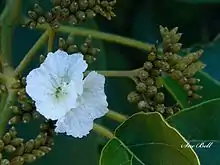| Cordia africana | |
|---|---|
 | |
 | |
| Scientific classification | |
| Kingdom: | Plantae |
| Clade: | Tracheophytes |
| Clade: | Angiosperms |
| Clade: | Eudicots |
| Clade: | Asterids |
| Order: | Boraginales |
| Family: | Boraginaceae |
| Genus: | Cordia |
| Species: | C. africana |
| Binomial name | |
| Cordia africana | |
| Synonyms | |
| |
Cordia africana or Sudan teak is a mid-sized, white-flowered, evergreen tree in the borage family (Boraginaceae), native to Africa.[2] It produces edible fruit, and its wood is used for drums or other carpentry.
Uses
Cordia africana has been used in the manufacture of drums. The Akan Drum which is now in the British Museum was identified as being of African manufacture because it was found to be made from this tree.[3] It is also sometime called Sudan Teak and has been used for flooring, high-quality furniture, window making, interior decking. The wood can be used to manufacture beehives which can be kept in this tree where the bees can live off the plentiful supply of nectar which comes from the flowers. In addition the tree supplies leaves for forage and an edible fruit.[2][4]
References
- ↑ Botanic Gardens Conservation International (BGCI) & IUCN SSC Global Tree Specialist Group. (2020). Cordia africana. The IUCN Red List of Threatened Species 2020: e.T61986332A146444347. doi:10.2305/IUCN.UK.2020-2.RLTS.T61986332A146444347.en. Accessed on 17 April 2022.
- 1 2 "Cordia africana" (PDF). AgroForestryTree Database. Archived (PDF) from the original on 2021-01-31. Retrieved 4 October 2010.
- ↑ MacGregor, Neil. "Akan Drum". A History of the World in 100 Objects. BBC. Retrieved 4 October 2010.
- ↑ "Sudan Teak (Tectona Grandis)/ Cordia Africana". Archived from the original on 2020-10-24. Retrieved 24 January 2021.



